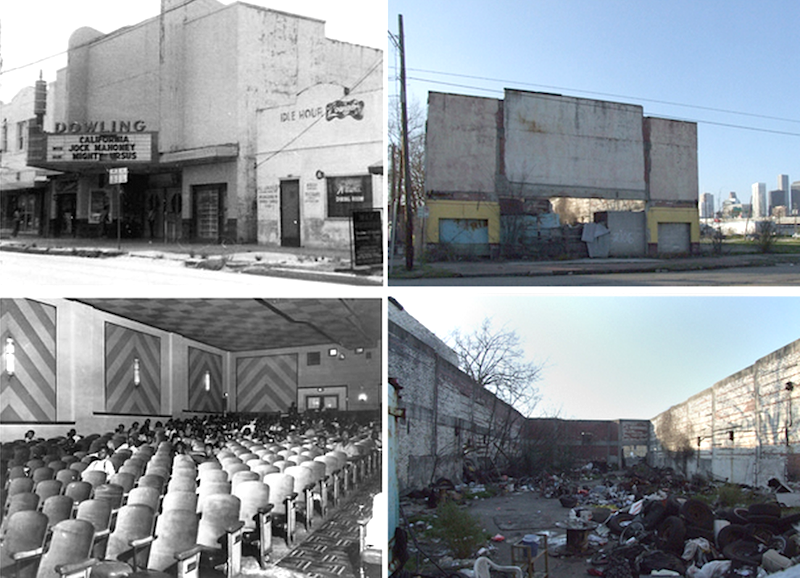
Left: Dowling Theatre exterior, 1963. Courtesy Ray M. Boriski. Bottom left: Dowling Theatre interior, c. 1960. Courtesy Houston Metropolitan Research Center, Houston Public Library, MSS 210. Top and bottom right: Dowling Theatre, c. 2007. Courtesy arch-ive.org
It could be argued that photography is the most accessible art form. From television and print advertisements to the images we capture with our smartphones, we engage with photographs on a daily basis. Our relationship with the medium often begins early in life, starting with our own image. Those of us who are of a certain age might have chronicled this relationship in a family photo album, the most personal of archives. From important rites of passage to the most mundane events, family photo albums show our life trajectory and usually include some pictures in which we appear less than attractive to our own eyes. While there may be countless other images that better represent us, we still resist photographs that we dislike, anxious that they will find their way into the world, becoming fixed in the minds of others and influencing their perceptions of us. These concerns extend to the cities and neighborhoods where we reside. If we happen to inhabit places marked by poverty or dilapidation, narratives of despair and failure, our association with them marks us as failures, too.
The role that photography plays in public perceptions of a place is a complicated matter. I was reminded of this when I encountered Unity Foto Bank, an ongoing project by artist Jamal Cyrus, working in collaboration with photographer Ray Carrington III. Unity Foto Bank unfolds in two different forms: a Tumblr and a site-specific installation at Project Row Houses in Houston, Texas. Both attempt to illustrate the history of Houston’s Third Ward, mostly through photographs and photo-based images of individuals and landmarks that were instrumental in shaping the tenor and culture of the this historic and largely African American community. Although the Third Ward is a dynamic, architecturally and economically diverse area, images of strife and decay are often circulated in the public. Unity Foto Bank is a gesture toward bridging gaps in the community’s architectural and photographic memory. Archival images, amateur snapshots, flyers, and other ephemera present a continuum of experiences and stages in Third Ward’s history. Perusing the website or installation, one will encounter images of the area during its heyday, when it was thriving and economically self-sufficient, as well as when parts of it began to decline. Residents are encouraged to submit their own images so that this archive is not only communally orchestrated but also continually evolving.
I came across one image on the Tumblr that gave me pause: a spliced photograph of the Dowling Theatre. One half of the image shows a resplendent Art Deco movie house in the early 1960s. The other half shows the same structure in 2007, by then a shell of its former glory. Its façade has been stripped of the architectural details that made it so appealing and the interior is filled with detritus. The image is jarring yet I found that this idea of a “failed” space did not surface for me, possibly because the photograph is juxtaposed with images of prosperous businesses in the community now. Dilapidation then is only an element of the Third Ward, not a prevailing narrative. Instead of being tethered to failure, this dichotomous image of the past and present, of change that has occurred over time, opens up a space for us to imagine new possibilities.
Unity Foto Bank is on view at Project Row Houses through March 2, 2014.